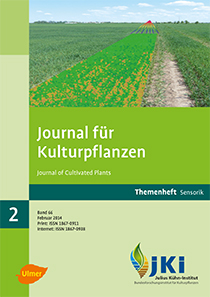Sensor system for reducing plant protection products in fruit growing
Keywords:
Penetration, foliage density, spray deposit measurements, sensor for gap switching, multiple regression analysis, reducing the amount of plant protection products, boom section switching systemAbstract
A considerable amount of plant protection products can be saved if plant protection product doses are adjusted to the foliage density of fruit trees and to the technical equipment parameters of air-assisted sprayers. The Institute for Application Techniques in Plant Protection at the Julius Kühn-Institute and the ESTEBURG – Fruit-Growing Centre in Jork were able to confirm this after carrying out studies over several years. For this purpose, following their analysis, four parameters were derived to characterise existing apple tree plantations in the 'Altes Land' (south of the Elbe in the counties of Hamburg and Lower Saxony). Using this as a basis, a model was developed for calculating the penetration and deposition of PPPs by evaluating extensive spray deposit measurements. At the same time, the main equipment parameters were also taken into consideration and their influence on penetration was determined. Assuming that spray loss (other side of the tree) is reduced and that equal spray deposits are generated where possible, the optimum PPP dose can be determined on the basis of the calculation model according to foliage density and equipment parameters. Instructions for adjustment show how reduced doses can be used in fruit growing. The Institute for Application Techniques in Plant Protection has acquired further project resources with the aim of adjusting dosages using a sensor system.
GPS-aided section switching systems have been the most significant assisting systems over the last few years as far as field sprayers are concerned. The Institute for Application Techniques in Plant Protection has developed a test method for such systems and has come to the conclusion that the systems available on the market at the moment work very precisely.
DOI: 10.5073/JfK.2014.02.05, https://doi.org/10.5073/JfK.2014.02.05
Downloads
Published
Issue
Section
License
The content of the journal is licensed under the Creative Commons Attribution 4.0 License. Any user is free to share and adapt (remix, transform, build upon) the content as long as the original publication is attributed (authors, title, year, journal, issue, pages).
The copyright of the published work remains with the authors. The authors grant the Journal of Cultivated Plants, the Julius Kühn-Institut and the OpenAgrar repository the non-exclusive right to distribute and exploit the work.







